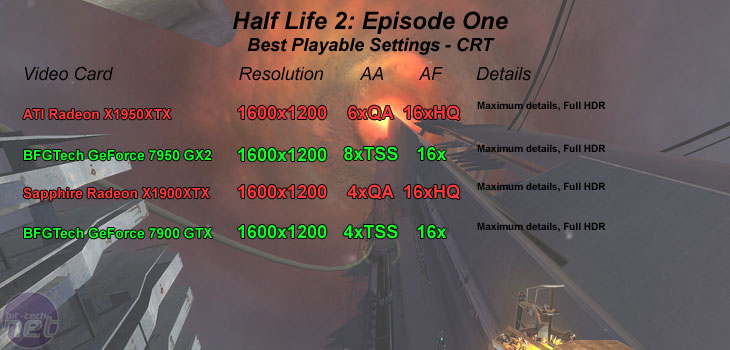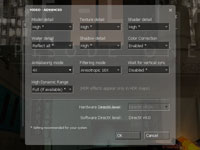For gameplay evaluations on a 24" widescreen monitor, please head straight to our widescreen performance section.
Half-Life 2: Episode One is the first in a series of episodes that extends the Half-Life 2 story far beyond where the original left off. Valve has implemented its HDR rendering and used it to great effect in Half-Life 2: Episode One. There are also new higher-resolution textures, new facial animations and some AI improvements made in the new game too.
Anti-aliasing and anisotropic filtering were controlled from inside the game, and thus the drivers were left set to "Application Controlled". There are three options for the method of HDR used in this title. You can either disable HDR completely, make use of "Bloom" which is just what it says and less resource hungry in comparison to "Full" which, again is just what it says. It utilises a full dynamic range with the iris effect too.
We have written quite a bit about Half-Life 2: Lost Coast, Day of Defeat: Source, Episode One and how Valve have implemented HDR in to the Source Engine. You can check out the articles listed below for more information on The Lost Coast & Day of Defeat: Source.
We did a five minute manual run through from the Exit 17 level. It involves lots of HDR, lots of explosions and both indoor and outdoor scenes. The section we have used is typical of some of the more stressful areas in the game. Thankfully though, the game runs superbly on a wide range of hardware, while still looking absolutely stunning.

 The Radeon X1950XTX delivered a fantastic gaming experience in Half-Life 2: Episode One on a CRT monitor. We were able to attain very smooth gameplay at 1600x1200 with 6x quality adaptive AA and 16x HQ AF enabled. Texture filtering was sharp and crisp as were transparent textures like chain fences. Edge aliasing was also non-existant, so game play looked pretty amazing on our 19" CRT.
The Radeon X1950XTX delivered a fantastic gaming experience in Half-Life 2: Episode One on a CRT monitor. We were able to attain very smooth gameplay at 1600x1200 with 6x quality adaptive AA and 16x HQ AF enabled. Texture filtering was sharp and crisp as were transparent textures like chain fences. Edge aliasing was also non-existant, so game play looked pretty amazing on our 19" CRT.
BFGTech's GeForce 7950 GX2 was capable of playing the game with higher anti-aliasing settings at 1600x1200, but the differences between NVIDIA's 8xAA and ATI's 6xAA are very small at the best of times. In all honesty, you are not going to notice the difference between 8xAA and 6xAA when you are immersed in Half-Life 2: Episode One - the differences are so small that you are going to require a magnifying glass.
One difference that did stand out on the two NVIDIA GeForce 7-series cards was the texture aliasing on brick walls - this simply didn't happen on the Radeon X1950XTX. The Source Engine can suffer from some quite harsh texture shimmering with NVIDIA's default quality settings, it seems that this doesn't completely go away with the high quality driver setting, either. Taking this into account, we think that the ATI Radeon X1950XTX delivered an overall better gaming experience in Episode One.
Half-Life 2: Episode One
Publisher: Valve SoftwareHalf-Life 2: Episode One is the first in a series of episodes that extends the Half-Life 2 story far beyond where the original left off. Valve has implemented its HDR rendering and used it to great effect in Half-Life 2: Episode One. There are also new higher-resolution textures, new facial animations and some AI improvements made in the new game too.
Anti-aliasing and anisotropic filtering were controlled from inside the game, and thus the drivers were left set to "Application Controlled". There are three options for the method of HDR used in this title. You can either disable HDR completely, make use of "Bloom" which is just what it says and less resource hungry in comparison to "Full" which, again is just what it says. It utilises a full dynamic range with the iris effect too.
We have written quite a bit about Half-Life 2: Lost Coast, Day of Defeat: Source, Episode One and how Valve have implemented HDR in to the Source Engine. You can check out the articles listed below for more information on The Lost Coast & Day of Defeat: Source.
- Half-Life 2: Lost Coast HDR overview
- Half-Life 2: Lost Coast hands on
- Half-Life 2: Lost Coast Benchmarks & Video
- Cinematic Effects in Source
- Liveblogging HL2: Episode One
We did a five minute manual run through from the Exit 17 level. It involves lots of HDR, lots of explosions and both indoor and outdoor scenes. The section we have used is typical of some of the more stressful areas in the game. Thankfully though, the game runs superbly on a wide range of hardware, while still looking absolutely stunning.


BFGTech's GeForce 7950 GX2 was capable of playing the game with higher anti-aliasing settings at 1600x1200, but the differences between NVIDIA's 8xAA and ATI's 6xAA are very small at the best of times. In all honesty, you are not going to notice the difference between 8xAA and 6xAA when you are immersed in Half-Life 2: Episode One - the differences are so small that you are going to require a magnifying glass.
One difference that did stand out on the two NVIDIA GeForce 7-series cards was the texture aliasing on brick walls - this simply didn't happen on the Radeon X1950XTX. The Source Engine can suffer from some quite harsh texture shimmering with NVIDIA's default quality settings, it seems that this doesn't completely go away with the high quality driver setting, either. Taking this into account, we think that the ATI Radeon X1950XTX delivered an overall better gaming experience in Episode One.

MSI MPG Velox 100R Chassis Review
October 14 2021 | 15:04










Want to comment? Please log in.